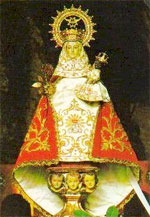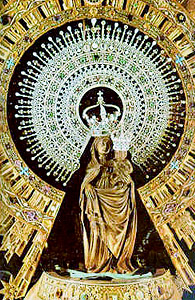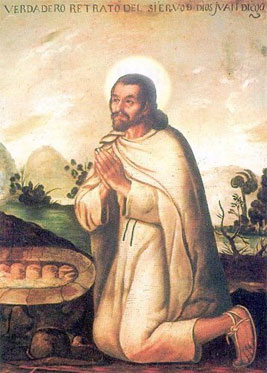Written by Plinio Corrêa de Oliveira (Orginally published on May 10, 1970 in the
Folha de S. Paulo )
Scene: A small town having all of the conventional characteristics of a small town: a central public square leading to a graceful church with stained-glass windows, a tower, bells, and a clock; across from the church, a water fountain; then, the homes, modest but comfortable; nearby, adjacent to one narrow street, an elementary school; then, more narrow streets, all of them blending into the peaceful green pastures at a distance; and not so far away, a dark forest, from which wild boars and packs of wolves come out with a certain frequency.

First character: A teacher, who instructs with angelic tenderness and patience. She is tall, alert, modest, and unpretentious.
Second character: A young shepherdess, who leaves early every morning to take her sheep to pasture. She is youthful, pure, loving, and at ease with isolation and prayer.
 |
| He has a hard job indeed, consisting of long journeys and tiring vigils. |
Third character: The hunter. He is not an inexperienced amateur, but a modest public servant, who is called from time to time to recruit the most courageous men in the small town and lead them into the dark forest to combat the voracious animals. It is a hard job indeed, consisting of long journeys and tiring vigils. He is between 20 and 30 years old, strong and powerful, a leader made for the job. His hair is thick and bushy; his walk, firm and heavy; his handshake, strong, enabling one to feel the calluses on his fingers. Early in the morning, one may see him coming back from a hunt, frequently carrying upon his shoulders a dead animal, still dripping warm blood. He is jovial and dedicated, and ever since he accepted the job, not a single wolf has come into the town, nor has a wild boar destroyed the crops. When he crosses the central public square, the comments that are made about him are not all identical. Some find him agreeable, appreciating his happy and youthful courage and his frank and masculine outlook. But others resent him. His presence in town makes them uncomfortable, especially when he recalls some of the unpleasant dangers he faces in the forest. The coldness with which he hunts, corners, wounds, and then kills animals blurs the vision of these persons, making it difficult for them to perceive the kindness of his soul. To see him happily carrying the blood-dripping body of an animal in the exercise of his brave profession, raises in the minds of some of his fellow residents the impression that he might be capable of spilling the blood of anything, even a human being. To sum the whole matter up, to some he appears to be the personification of masculinity, dedication, and talent; to others, he is a hideous image of fighting, violence, and war.
Fourth character: The grandfather. He looks his role, having a long white beard, deep clear eyes, and shaky and bony hands. He is a little deaf.
Fifth character: A retired businessman. He is between 50 and 60 years old, a little too fat, with beady eyes which move constantly. He is always changing the tone of his voice. At times it is serene; at other times, harsh; and at other times, almost whispering. He has traveled many places, analyzed many things, and become a little rich. He is the boss of the town, having solid contacts in all of the neighboring towns and villages. Through his hands pass all of the significant decisions, and everyone goes to him for advice about serious matters. By being in contact with him, everyone learns what is happening outside of the village and region.
Setting: A bar, small and crowded, where a subject of conversation has been established, and ideas about it are passing from one table to the next.
Theme: Everyone is talking about the main events of the year, and the conversation leads to the question of who is the most popular person in town?
There are many opinions. Some say it is the beautiful young shepherdess. When she leaves with her flock, she appears to be going out to meet her enchanted prince, so graceful and delicate is she.
When she returns slightly tired, she draws sympathy from all, as she symbolizes in a charming way the hardships of the pastoral work in which the residents of the region are engaged.
Others choose the teacher. To them, she represents learning, wisdom, culture, the wonderful goods of the spirit, and the opening of new opportunities for future generations. She is more than an agent of economic production; she is a factor of human edification. To them, she is a shepherdess of children, which should be worth more than to be the shepherdess of sheep. They recall the tenderness with which she conducts the children toward the central public square, to lead them in prayer, with the sound of the bells announcing the end of the activities of the day. They also recall the way she leads, afterwards, the children in play, around the fountain, singing and skipping, before taking them back to their homes.
Nobody knows with certainty whom to choose. There is not a person who fails to appreciate both of them. But soon the leaders of two trends of thought begin to appear, seeking the answer to a higher problem. Which is worth more: the prosperity symbolized by the one, or the knowledge symbolized by the other? And from another point of view, which deserves the greater honor: the grace of the shepherdess, or the sweet seriousness of the teacher? These are universal problems, problems of all times, which for this very reason arouse great interest.
 |
| When the shepherdess leaves with her flock, she appears to be going out to meet her enchanted prince, so graceful and delicate is she. |
During a lull in the discussion, the voice of the grandfather is heard: "What about heroism? It too has its merit. It is a merit which we must take into consideration if we are going to be fair. We are talking about merits, aren't we? As you all know, I was a soldier. I could feel the wonder of the wind that lifted our enthusiasm in the hours of combat. We fought hard so that the normal life of labor, prayer, study, and rest might continue: the shepherds leading their sheep to pasture, the teachers instructing their pupils, the wives preparing their homes for their husbands returning from work, and the churches raising prayers for the glory of God in the highest of heavens and for peace on earth to men of good will. We fought so that the principles of justice and charity, upon which the whole Christian order is based, would not be violated by an aggressor and enemy. Our souls became enlarged proportionately to the ideal for which we were fighting. Our temper became stronger than steel, and our courage greater than the wild boar or the voracious wolf. We would go forth happily to fight, to wound, and to kill, knowing that we might be wounded and even die. The ideal was everything.
Oh, how wonderful was that ideal, how beautiful the fight in its sacred grandeur."
The old man was standing up now. His deep voice could be heard in the silence of the room. No one imagined that such a frail figure could monopolize the attention of the participants in the room as he did. Then, the old man, becoming tired, sat down. His last words: "I propose that you go beyond the teacher and the shepherdess, and also consider if there is a place for the name of our hunter of wild beasts. Couldn't there be a place of honor for someone who is a hero?"
There was emotion and a certain uneasiness among the listeners. They recalled that some days ago the parish priest made a sermon in which he spoke about these words of Our Lord: "Greater love has no man than he lay down his life for his friend."
* * *
The debate continued, and the parties were still divided. But now everyone was either for or against the heroic guardian. Those who were against him no longer cared whether the shepherdess or the teacher won first place. All that they wanted now was to keep the guardian from getting the place of honor. But there were others who were convinced that it was indispensable to honor the hero.
As was usual in that small town, when the time arrived to make the important decision, the businessman took the floor. Everyone turned toward him, and, little by little, that ever-changing voice began to be heard. He touched everyone's heart when he enthusiastically praised the mission of the shepherdess. They were all convinced when he spoke about the importance of culture. And at last, as if pronouncing the final verdict, addressing himself to the old man, he said he respected him, but the days of fighting were gone. The world would one day proceed and indeed had already begun to fuse all religions, all races, and all peoples. Intelligent men could have nothing but horror for the spilling of blood. The fact that someone, upon being hired, had accepted the mission of killing wild animals, was a sad necessity, but to place fighting and the pre tense of heroism on the same level with culture and economic production was an anachronism. The businessman concluded by proposing the removal of the name of the slayer from the list, but at the same time asked all to show their esteem for the old man by giving him a hand.
Everyone clapped his hands. Only a few appeared unhappy.
It was late, and they decided to leave.
The next morning no one saw the hunter at the square. They didn't see him any time after that either. He had decided to move to other lands, far away, to become rich doing something less dangerous. And the small town forgot about the incident.
Next year the number of wild boars and voracious wolves increased a little. The year after that, their number increased still more. In the third year, the number of farms decreased. Some children had been made orphans and some families had become poor.
The retired businessman complained: "How can one live in such a place?" And he moved away.
As for the small town, it continued to decay and to die.
* * *
What should this story be called? What title should be given to this article?
"Peace, Culture, and Heroism?" Or maybe, "Ungratefulness and Punishment?" I don't know. Maybe we could call it, "The Crime of the Villianous Demagogue." Another idea, "The Hawks and the Doves;" perhaps this would be the best.
The reader may choose for himself.














